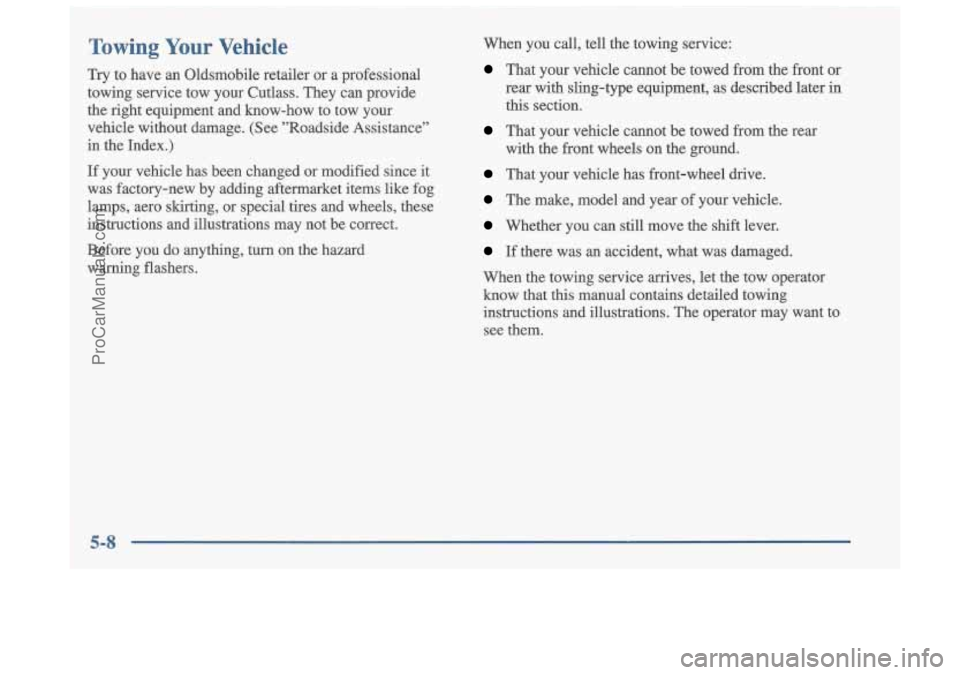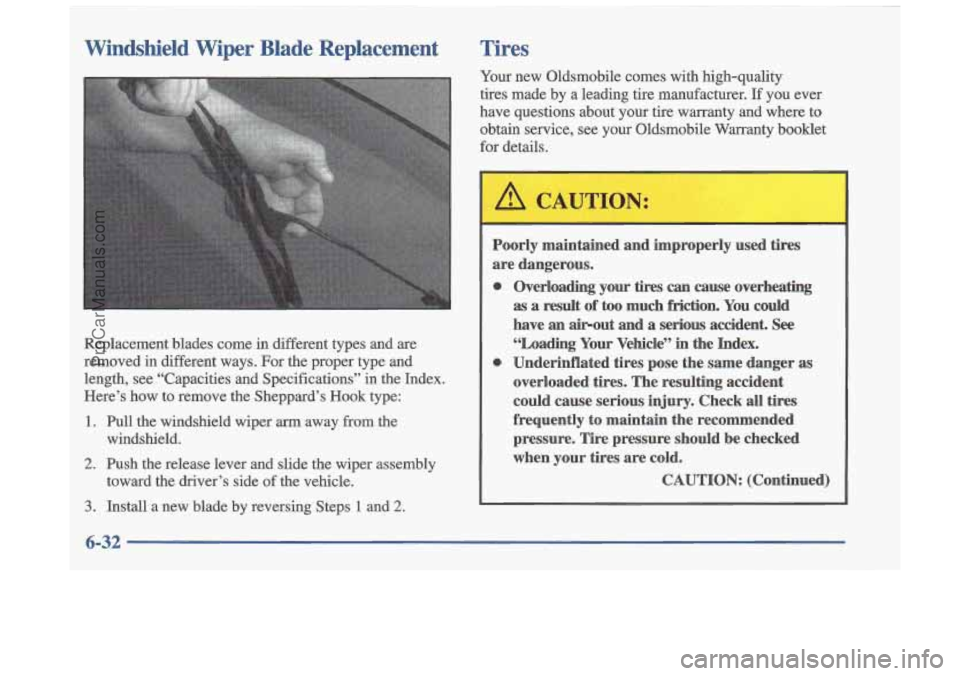1997 OLDSMOBILE CUTLASS tire type
[x] Cancel search: tire typePage 158 of 353

0
0
0
0
Check your mirrors, glance over your shoulder, and start your left lane change signal before moving out
of the right lane to pass. When you are far enough
ahead of the passed vehicle to see its front in your
inside mirror, activate your right lane change signal
and move back into the right lane. (Remember that
your right outside mirror is convex. The vehicle you
just passed may seem to be farther away from you
than it really is.)
Try not to pass more than one vehicle at a time on
two-lane roads. Reconsider before passing the
next vehicle.
Don’t overtake a slowly moving vehicle too rapidly.
Even though the brake lamps are not flashing, it may
be slowing down or starting to
turn.
If you’re being passed, make
following driver to get ahead
can ease a little to the right. it easy
for the
of you. Perhaps
you
Loss of Control
Let’s review what driving experts say about what
happens when the three control systems (brakes, steering
and acceleration) don’t have enough friction where the
tires meet the road
to do what the driver has asked.
In any emergency, don’t give up. Keep trying to steer and
constantly seek
an escape route or area of less danger.
Skidding
In a skid, a driver can lose control of the vehicle.
Defensive drivers avoid most skids by taking reasonable
care suited to existing conditions, and by not “overdriving”\
those conditions. But skids are always possible.
The three types
of skids correspond to your
Oldsmobile’s three control systems. In the braking
skid,
your wheels aren’t rolling. In the steering or cornering
skid, too much speed or steering
in a curve causes tires
to slip and lose cornering force. And in the acceleration
skid, too much throttle causes the driving wheels to spin.
4-13
ProCarManuals.com
Page 188 of 353

Section 5 Problems on the Road
Here you’ll find what to do about some problems that can occur on the road.
5-2
5-2
5-3
5-8
5- 10
5-11
5-12 5-13
How to Use Warning Flashers
Other Types of Warning Devices
Step-by-step Procedure for Jump Starting
Information
You Should Know Before Towing
Towing Your Vehicle From the Front
Towing Your Vehicle From the Rear
If Your Engine is Overheating
If Steam is Coming From
Your Engine
5- 16
5-20
5-2
1
5-30
5-32
5-33
5-33
How to Add Coolant
What to do if a Tire Goes Flat
How to Change a Flat Tire
Where to Store the Flat Tire and Tools
Information on the Compact Spare Tire
If You’re Stuck in Sand, Mud, Snow or on Ice
How to Rock Your Vehicle
5-1
ProCarManuals.com
Page 195 of 353

Towing Your Vehicle
Try to have an Oldsmobile retailer or a professional
towing service tow your Cutlass. They can provide
the right equipment and know-how to tow your
vehicle without damage. (See "Roadside Assistance"
in the Index.)
If your vehicle hasbeen changed or modified since it
was factory-new by adding aftermarket items like fog
lamps, aero skirting, or special tires and wheels, these
instructions and illustrations may not be correct.
Before you do anything,
turn on the hazard
warning flashers. When you call,
tell the towing service:
That your vehicle cannot be towed from the front or
rear with sling-type equipment, as described later
in
this section.
That your vehicle cannot be towed from the rear
with the front wheels on the ground.
That your vehicle has front-wheel drive.
The make, model and year of your vehicle.
Whether you can still move the shift lever.
If there was an accident, what was damaged.
When the towing service arrives, let the tow operator
know that this manual contains detailed towing
instructions and illustrations. The operator may want to
see them.
ProCarManuals.com
Page 224 of 353

Section 6 Service and Appearance Care
Here you will find information about the care of your Oldsmobile. This section begins with service and fuel
information, and then it shows how to check important fluid an\
d lubricant levels. There is also technical information
about your vehicle, and a part devoted to its appearance care.\
6-2 6-3
6-5
6-5 6-7
6-11 6- 16
6-16
6-21
6-22
6-25
6-26
6-26
6-32
6-33 Doing
Your Own Service Work
What Kind of Fuel to Use
Using Fuel in Foreign Countries Where to Put the Fuel and Filling the Tank
Checking Things Under the Hood
Checking Your Engine Oil
Automatic Transaxle Fluid
Engine Coolant
Where to Fill the Windshield Washer Fluid
Important Brake Information
Infomation on Your Vehicle’s Battery
Tips on Vehicle Storage
Bulb Replacement Procedures
Windshield Wiper Blade Replacement How and When to Check Tire Inflation When
it is
Time to Buy New Tires
Wheel Alignment Cleaning the Inside of Your Vehicle
Care of the Safety Belts
Cleaning the Outside of Your Vehicle
How to Clean Aluminum Wheels
Underbody Maintenance
Recornended Appearance Care Materials
Your Vehicle Identification Number (VIN)
The Electrical System
Fuses and Circuit Breakers
Replacement Bulb Types for Your Vehicle
Capacities and Specifications
Air Conditioning Specifications
Normal Replacement Parts
6-35
6-38
6-4
1
6-43
6-45 6-46
6-47
6-48
6-49
6-50
6-5 1
6-57
6-57
6-58
6-58
6-1
ProCarManuals.com
Page 255 of 353

Windshield Wiper Blade Replacement Tires
Replacement blades come in different types and are
removed in different ways. For the proper type and
length, see “Capacities and Specifications’’ in the Index.
Here’s how
to remove the Sheppard’s Hook type:
1. Pull the windshield wiper arm away from the
windshield.
2. Push the release lever and slide the wiper assembly
toward the driver’s side of the vehicle.
3. Install a new blade by reversing Steps 1 and 2.
Your new Oldsmobile comes with high-quahty
tires made by
a leading tire manufacturer. If you ever
have questions about your tire warranty and where to
obtain service, see your Oldsmobile Warranty booklet
for details.
I
0
0
Poorly maintained and improperly used tires
are dangerous.
Overloading your
tires can cause overheating
as a result of too much friction. You could
have
an airout and a serious accident. See
“Loading Your Vehicle” in the Index.
Underinflated tires pose the same danger as overloaded tires. The resulting accident
could cause serious injury. Check all tires
frequently to maintain the recommended
pressure. Tire pressure should be checked
when your tires are cold.
CAUTION: (Continued)
6-32
ProCarManuals.com
Page 257 of 353

When to Check
Check your tires once a month or more.
Don’t forget your compact spare tire. It should be at
60 psi (420 Ea).
How to Check
Use a good quality pocket-type gage to check tire
pressure.
You can’t tell if your tires are properly inflated
simply by looking at them. Radial tires may look
properly inflated even when they’re underinflated.
Be sure to put the valve caps back on the valve
stems. They help prevent leaks by keeping out dirt
and moisture.
Tire Inspection and Rotation
Tires should be rotated every 6,000 to 8,000 miles (10
000 to 13 000 km). Any time you notice unusual wear,
rotate your tires
as soon as possible and check wheel
alignment.
Also check for darnaged tires or wheels. See
“When It’s Time for New Tires” and “Wheel
Replacement” later
in this section for more information.
The purpose of regular rotation is to achieve more
uniform wear for
dl tires on the vehicle. The first rotation is the most important.
See “Scheduled
Maintenance Services” in the Index for scheduled
rotation intervals.
When rotating your tires, always use the correct rotation
pattern shown here.
Don’t include the compact spare
tire in your tire rotation.
After the tires have been rotated, adjust the front and
rear inflation pressures as shown on the Tire-Loading
Information label. Make certain that all wheel nuts are
properly tightened. See “Wheel Nut Torque” in
the Index.
6-34
ProCarManuals.com
Page 259 of 353

Buying New Tires
To find out what kind and size of tires you need, look at
the Tire-Loading Information label,
The tires installed on your vehicle when it was new had
a Tire Performance Criteria Speclfication (TPC Spec)
number on each tire’s sidewall. When you get new tires,
get ones with that same TPC Spec number. That way
your vehicle will continue to have tires that are designed
to give proper endurance, handling, speed rating,
traction, ride and other things during normal service on
your vehicle.
If your tires have an all-season tread
design, the TPC number will be followed by an
“MS”
(for mud and snow).
If
you ever replace your tires with those not having a
TPC Spec number, make sure they are the same size,
load range, speed rating and construction type (bias,
bias-belted or radial) as your original tires. Mixing
tires could cause you to lose control while
driving.
If you mix tires of different sizes or types
(radial and bias-belted tires), the vehicle may not
handle properly, and you could have a crash.
Using tires
of different sizes may also cause
damage to your vehicle. Be sure to use the same
size and type tires on
all wheels.
I
It’s all right to drive with your compact spare,
though.
It was developed for use on your vehicle.
6-36
ProCarManuals.com
Page 260 of 353

Uniform Tire Quality Grading
The following information relates to the system developed by the United States National Highway
Traffic Safety Adrninistration, which grades tires by
treadwear, traction and temperature performance.
(This
applies only to vehicles sold in the United States.) The
grades are molded on the sidewalls of most passenger
car tires. The Uniform Tire Quality Grading system does
not apply to deep tread, winter-type snow tires,
space-saver or temporary use spare tires, tires with
nominal
rim diameters of 10 to 12 inches (25 to 30 cm),
or to some limited-production tires.
While the tires available on General Motors passenger
cars and light trucks may vary with respect to these
grades, they must also conform to Federal safety
requirements and additional General Motors Tire
Performance Criteria (TPC) standards.
Treadwear
The treadwear grade is a comparative rating based on
the wear rate of the tire when tested under controlled
conditions on a specified government test course. For
example, a tire graded 150 would wear one and a half
.
(1 1/2) times as well on the government course as a tire
graded
100. The relative performance of tires depends
upon the actual conditions of their use, however, and
may depart significantly from the norm due to variations
in driving habits, service practices and differences
in
road characteristics and climate.
Traction -- A, B, C
The traction grades, from highest to lowest, are A, B, and
C, and they represent the tire’s ability to stop on wet
pavement
as measured under controlled conditions on
specified government test surfaces of asphalt and concrete.
A tire marked C may have poor traction performance.
Warning: The traction grade assigned to this tire is based
on braking (straight ahead) traction tests and does not
include cornering (turning) traction.
ProCarManuals.com